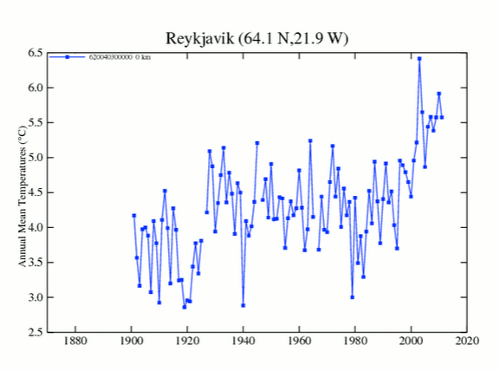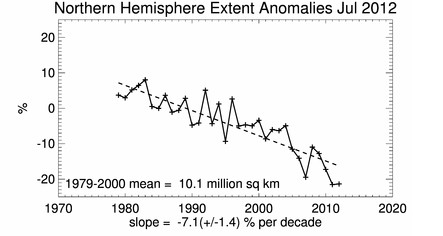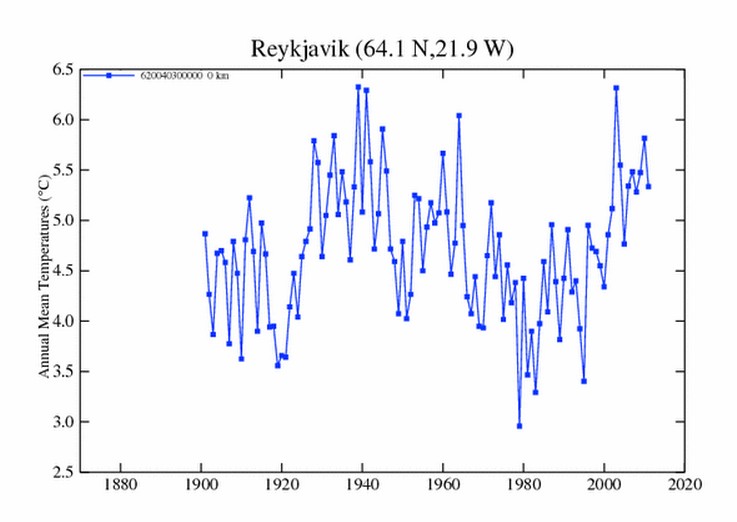NSIDC wants us to believe that satellite measurements began in 1979.
But satellite records go back much further, and showed ice gain in the 12 years prior to 1979. Paul Homewood found this quote from the CRU Director HH Lamb
Kukla & Kukla (1974) report that the area of snow and ice, integrated over the year across the Northern Hemisphere, was 12% more in 1973 than in 1967, when the first satellite surveys were made.
HH Lamb–“Climate: Present, Past & Future–Vol 2”–In Review–Part II « NOT A LOT OF PEOPLE KNOW THAT
From 1974 to 1979, the IPCC showed another large gain

www.ipcc.ch/ipccreports/far/wg_I/ipcc_far_wg_I_full_report.pdf
If NSIDC showed the complete satellite data set, people would know that Arctic behavior was cyclical, as we can see in the original GISS temperature graph from Iceland
Data.GISS: GISS Surface Temperature Analysis
Hansen of course didn’t want us to know about this cyclical behavior either, so he got rid of it. You can do that when you are an activist, who also controls the data.





So “manipulation” of temperature station data melted the Arctic Sea Ice, turned the mass-balance of Greenland strongly negative etc.?
You are an idiot Gonzo
Idiot is generous to say.
Zooom right over your head.
When will you get tired showing the world about your lack of debate skills?
Steve made a presentation using actual data showing that it is a cyclic phenomenon but of course that was too difficult for you to understand.
The Arctic Sea Ice did not melt due to unusually warm temperatures. It was broken up by an out of season severe cold August blizzard that caused unusual mixing from below, per our friend, Dr. Julienne . So you are spreading disinformation.
Global warming is all about disinformation. How about that email that talked about getting rid of the Medieval Warm Period!
Not only is Gonzo an idiot, but who the hell cares if the Arctic melts? What the hell difference is that going to make for anything? … please explain …
It will change the weather in the Northern Hemisphere due to changes to the jet stream, or that’s the current theory. You can argue that this does not matter unless you’re a farmer.
As I have the wonderful good fortune to be involved in farming I can tell you that weather has always been cyclical according to old farming records . England is a good example as they have some decent reliable records that demonstrate the ability to grow various crops for many years and then lose that ability due to cooling . Presently here in NW Oregon we are going into a cooling cycle according to the apple varieties so you do need to check the farming records and realize that farmers adjust to the climate conditions and they don’t go screaming hystericaly about the need to destroy the industrial ability of the nation in a wild and idiotic quest to change the climate .
“or that’s the current theory” … exactly .. And tell me exactly how this will affect farming. How do you know it is good, or bad, good for one, bad for another?
Seems to me, if the Arctic is already sooooo close to being ice free, then would we not already be seeing these ill effects that you speak of? Or does the Arctic have to be completely void of every ice cube and Budweiser cooler for this to magically happen?
Well Gondo, with the ice gone the NH will warm up further and that is good, extended growing seasons are needed to feed 7 billion of the human species. Greenland will become productive again like it was in the MWP. To feed these people we need a warm NH as there is far more land in the north then in the south, unless we all want to eat kelp the north is where the food production will need to come from.
There will be fewer storms and more settled weather as in the MWP.
To grow more plant crops for food we need more CO2. The more CO2 the faster they will grow. Having said all that we can easily feed all these people at the moment if it was not because of land used for misguided biofuel production, however well meant. Food would also have been more affordable and this will help the poor more then anything. Corn and soy prices will halve if we stop this waste of space.
“the IPCC, seek mechanisms of change within the terrestrial system, whether it’s ENSO, the Jet Stream, Pacific Decadal Oscillation (PDO), Atlantic Multivariate Oscillation (AMO) or other fluctuations. It is more likely the changes are driven externally. There’s a possible mechanism to explain major wind pattern changes like ENSO and the Rossby Waves.”
http://drtimball.com/2012/what-causes-el-nino-la-nina-ipcc-doesnt-know-but-builds-models-and-makes-projections-anyway/
Reblogged this on Climate Ponderings.
Hmm. Quite unclear from that second chart how that “incline” lines up with the seasons. Summer-to-winter change?
Strange: Look at around 1985. It happens *again*. The lows of ’85 to the highs of around ’87. The highs aren’t quite as high, but it’s close, and you can see that the trendline moves about the same amount.
In any case, look at the left axis. The total swing there is 1.5 – 2 million sq km.. respectable, but we’ve lost way more than that since the ’70s.
I’m going to recommend to Romney that he name Marc Morano head of the EPA. 🙂
We can open a Grand Jury on all the kooks at NOAA and GISS. Have a nice look see at each and every variable and coefficient. Execute terminations for cause. Maybe file some criminal charges. Eviscerate the scam.
Relax Traitor, you spend way too much time on satanist republican websites 🙂
ps. Hitler would haver like your hardline-approach to curbing scientific freedoms.
Yeah Gondo, you’re happy with Lisa Jackson as head of the EPA who says “Greenhouse gases are pollution”.
There’s Gondo’s real science. The atmosphere is pollution! Yeah for Gondo! Let’s get rid of all that pollution in the atmosphere, all of those polluting greenhouse gases. What a man of science you are Gond. Such purity in truth. No love for politics and political propaganda anywhere to be found in your comments!! Yes, truly, greenhouse gases are pollution. That is real science! All scientists will agree on it. All science text books write will about it, that evil atmosphere, pure pollution to the earth.
Yes Gondo, thank God you are saving us from our rank ignorance. Keep up the river of pure knowledge and information in science which are your comments!! Thank you so much comrade!
BTW, how long till you disappear like all other commenters of your ilk? Please don’t forsake us. We all so desperately need you mind. The world would be such a dark, oppressive place without you.
Here’s a video of the scientific brilliance of Lisa Jackson, head of the EPA, Obama appointee. America is in good hands with Barack Obama!
http://www.youtube.com/watch?v=iRQOeRYdpa4
scientific freedoms ? ? ? ? ? ? where ?
Hey Gond, I again implore you, do some basic, fundamental research and learn your geopolitical history before making yourself look anymore the fool. You have absolutely no clue what Communism, Socialism, Fascism, or any other ‘ism is. This is so typical of our present day culture, they have no freaking idea what Socialism or Communism is, but think it is cool and fashionable (just like Chè Guevara t-shirts). Gond, books are your friends. There has been plenty written over the centuries about these ‘ism’s and you would do yourself a great service by learning about them before you speak.
Sheeesh, kids, you give’em books and they just eat the covers.
NSIDC explains the reason it uses 1979 on its website:
“The passive-microwave data used for the Sea Ice Index is especially helpful because the sensor can ‘see’ through clouds and deliver data even during the six months of Arctic darkness and frequently cloudy conditions. Some other satellite sensors cannot penetrate clouds to take data, so the results are sporadic and dependent upon weather conditions. Still other sensors can see through clouds, but they do not cover the entire region of the globe where sea ice exists every day, making near-real-time monitoring difficult. Furthermore, some sensors cannot provide information in winter, when polar darkness prevails.
The passive microwave sea ice record dates back to 1979, one of the longest environmental data sets we know of. This provides a long-term product that consistently tracks changes in the ice cover over many years, lending additional confidence to the trends that we observe. So, although NSIDC refers to additional satellite data in developing our analysis, we primarily rely on passive-microwave data for Arctic Sea Ice News & Analysis images and content, and for tracking long-term change.”
http://nsidc.org/arcticseaicenews/faq/#data_sea_ice_index
Which is completely legitimate – as long as you limit your discussion, interpretation and conclusions to the 1979+ period, AND note that pre-1979 data shows variations that may indicate that the post ’79 variations are neither unusual nor indicative of a long-term change in patterns.
Which they didn’t do.
You would think that the Hansen-era temperature profile changes to the world would have been created within an agency that harbours many technical people who know better and wish to say so. You would think that the consistency of changes to the profiles of other nations, including Iceland, would have resulted in official objections and public withdrawal of support for anything based on data from their country as massaged by Hansen’s teams. You would think Wiley Coyote would give up chasing the Roadrunner.
Cartoon people and cartoon characters. Sometimes hard to explain either. Or tell them apart.
But they told us Arctic ice loss began in the 50’s. You mean they lied to us? They are liars. They tells lies? Yes, they lied to us. They are liars They tell lies.
Amino,
I believe that’s where this one comes in, based on ships reports, areal surveys and the like.
http://arctic.atmos.uiuc.edu/cryosphere/IMAGES/seasonal.extent.1900-2010.png
*aerial surveys
From the same IPCC report as Steven links to, page 224:
“Sea-ice limits have long been observed by ships, and harbour logs often contain reported dates of the appearance and disappearance of harbour and coastal ice. These observations present many problems of interpretation (Barry, 1986) though they are thought to be more reliable after about 1950. Changes and fluctuations in Arctic sea-ice extent have been analysed by Mysak and Manak (1989); they find no long term trends in sea-ice extent between 1953 and 1984 in a number of Arctic ocean regions but substantial decadal time scale variability was evident in the Atlantic sector.”
http://www.ipcc.ch/ipccreports/far/wg_I/ipcc_far_wg_I_full_report.pdf
There’s also this graph from NSIDC that is 1953-2011. I’d be curious if Julienne was around to hear why there are some differences between the anomalies here and the ones that show up in the IPCC report. Different analysis method?
http://nsidc.org/cryosphere/sotc/images/mean_anomaly_1953-2011-v2.png
It also makes me curious as to why the IPCC mentioned the other methods for the years previous to 1972, but did not provide a graph for thos years so a better comparison could be made between the data sets.
Actually, now that I look at the two again (IPPC and NSIDC), they don’t look hugely different; I just forgot the IPCC graph ends at 1990. Both graphs show a low point from 1972-75, a peak in the late 1970s, and then a steady rate or slight decline until 1990 save a dip around 1985. Not so different as I first thought. The explanation for the NSIDC graph is as follows:
“Mean sea ice anomalies, 1953-2011: Sea ice extent departures from monthly means for the Northern Hemisphere. For January 1953 through December 1979, data have been obtained from the UK Hadley Centre and are based on operational ice charts and other sources. For January 1979 through December 2011, data are derived from passive microwave (SMMR / SSM/I). Image by Walt Meier and Julienne Stroeve, National Snow and Ice Data Center, University of Colorado, Boulder.”
So there appears to be an overlap of the IPCC’s satellite-derived graph and the time period when NSIDC was still using the ships reports and other data. Both methods seem to agree on the anomalies over that time period.
I am saying there are alarmists who say the current ice loss began in the 1950’s. I should have made that very clear. I did not. It was a shortcoming on my part. My sarcasm was not aimed at a right target.
I know there was ice loss in the 50’s. I know the Arctic had broken up ice at the North Pole in the 50’s.
But ice grew after that and before the loss that start around 1980.
Gotcha. Thanks for the clarification.
Try going to real historic science and observational data from 1934 Zubo journal.section 162 warming of the Arctic.
http://archive.org/details/arcticice00zubo
Ahlmen explored the glaciers in 1934 and found that they were melting faster than they were growing he terms the rapid receding of the spitzbergen glaciers as catastrophic.
You have not supplied a source for the (changes in) last chart, can you post where you got information from?
goddard, you are misinterpreting the IPCC graph, though i admit it is poorly explained in the original document. it shows variations from the mean extent so of course sometimes it will be negative and sometimes positive. the point is that the anomaly in 1974 of about -1 million km2 is big, but right now the anomaly is more like -3 million km2 which is huge. and it is way beyond the 2 standard deviation envelope so is very unlikely to be due to random noise.
also, when comparing current ice extent with the 2007 minimum, please don’t compare august 2012 with october 2007–you should be comparing august 2012 with august 2007, which clearly shows a decrease in extent of at least 20% now compared to the same time in 2007.
when you do these kinds of things you come off as either not having any idea what you’re doing, or being purposefully deceptive.
And how does that refute anything I said?
it was not really meant to refute, but clarify. in the IPCC graph, you imply that including data from ~1970 thru 1978 would somehow change the conclusion that the current ice extent anomaly is not unusual in the past 40 years, but it still is huge compared to anything from the last century during the satellite record. it would reduce the mean a little bit, thus reducing the magnitude of the current anomaly a little, but the conclusions about the decrease wouldn’t change.
also on that graph–i hope you’re not implying that the IPCC or NSIDC have satellites? the only satellites the IPCC has are the ones that monitor your carbon footprint. just kidding. really.
as for the comparison of august 2012 with october 2007, this is exactly the kind of shoddy analysis climate scientists are often accused of on blogs like this one. if i compared august 2012 with june 2007, i’d see that there’s an astounding 8 million km2 less ice now (60-70%), proving catastrophic ice loss. but that’s nonsense (i’ve discovered the seasonal cycle!)–the only comparison that makes sense in this context is comparing the same time from each year. anything else is deliberately misleading and dishonest.
The IPCC graph doesn’t have any month resolution on it – how could I possibly have known what months they represent? Apparently you have the source for it? Fascinating.
ok, apparently i’m still not being clear, and i apologize for that.
1) on the IPCC graph, the point is not monthly resolution but that including the decade of the 1970s wouldn’t change the conclusions that the current anomaly is way beyond anything expected from random noise. including just 1979-2012 does not accentuate the sea ice decline–it would only slightly alter the reference value (mean). you imply that the results would change significantly.
2) by the way, if you want monthly resolution you can go to the nsidc web site and download it just like i did. you can probably do the analysis in excel.
3) the remainder of the comment (comparing august to october) is in reference to “NOAA Showing 14 % More Ice Than The 2007 Minimum”. first, i’m not sure where you got 14% (is that where the “counting pixels” crack came from?). the point is that even though noaa is making a big deal about this, you shouldn’t directly compare august distributions with september and conclude that we really aren’t seeing a record breaking year. once we get to the minimum in september there will likely be no question about it.